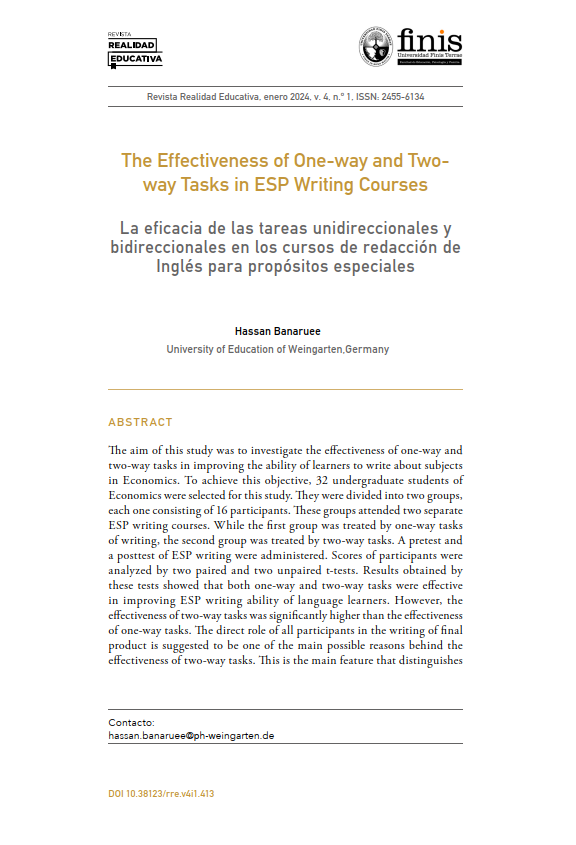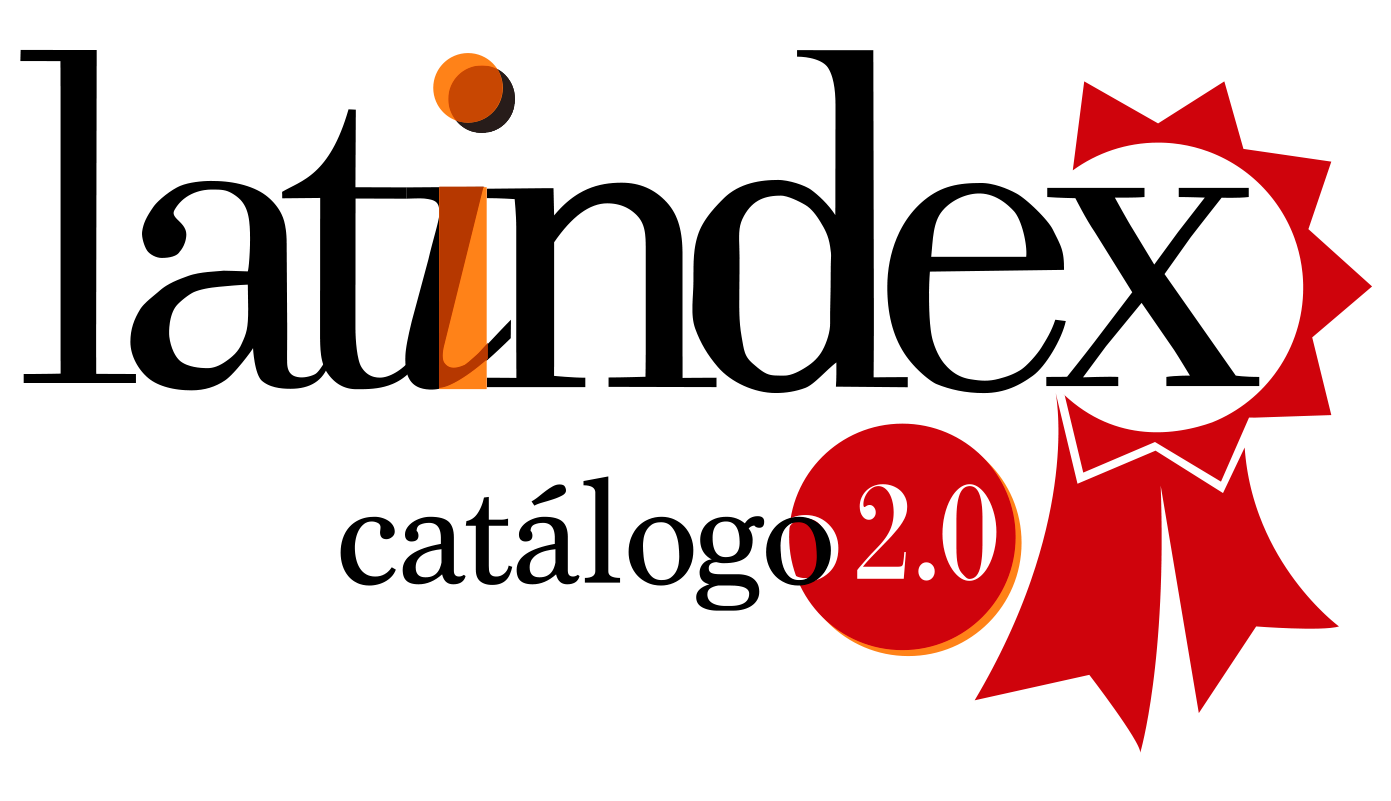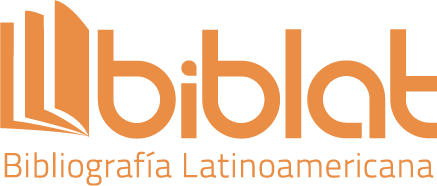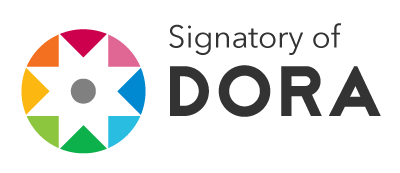The Effectiveness of One-way and Two-way Tasks in ESP Writing Courses
DOI:
https://doi.org/10.38123/rre.v4i1.413Keywords:
one-way task, two-way task, ESP, writing, foreign language teachingAbstract
The aim of this study was to investigate the effectiveness of one-way and two-way tasks in improving the ability of learners to write about subjects in Economics. To achieve this objective, 32 undergraduate students of Economics were selected for this study. They were divided into two groups, each one consisting of 16 participants. These groups attended two separate ESP writing courses. While the first group was treated by one-way tasks of writing, the second group was treated by two-way tasks. A pretest and a posttest of ESP writing were administered. Scores of participants were analyzed by two paired and two unpaired t-tests. Results obtained by these tests showed that both one-way and two-way tasks were effective in improving ESP writing ability of language learners. However, the effectiveness of two-way tasks was significantly higher than the effectiveness of one-way tasks. The direct role of all participants in the writing of final product is suggested to be one of the main possible reasons behind the effectiveness of two-way tasks. This is the main feature that distinguishes two-way tasks from one-way tasks and makes them superior to one-way tasks for improving writing ability of language learners.
Downloads
References
Askari, A., Khoshsima, H., Khatin-Zadeh, O., & Banaruee, H. (2017). Learners’ Factors in L2 Reading Comprehension. Global Journal of Educational Studi3(2), 63-78, https://doi.org/10.5296/gjes.v3i2
Banaruee, H., Farsani, D., & Khatin-Zadeh, O. (2022). EFL learners' learning styles and their reading performance. Discover Psychology, 2(45).href="https://doi.org/10.1007/s44202-022-00059-x"> https://doi.org/10.1007/s44202-022-00059-x =>
Banaruee, H., Farsani, D., & Khatin-Zadeh, O. (2023a). Culture in English Language Teaching: A curricular evaluation of English textbooks for foreign langulearners. Frontiers in Education, 8,1012786. https://doi.org/10.3389/feduc.2023.1012786
Banaruee, H., Khatin-Zadeh, O., & Farsani, D. (2023b). The challenge of psychological processes in language acquisition: A systematic review. Cogent Aramp; Humanities, 10(1). https://doi.org/ 10.1080/23311983.2022.2157961
Banaruee, H., Khatin-Zadeh, O., & Ruegg, R. (2018). Recasts vs. direct corrective feedback on writing performance of high school EFL learners. CogEducation, 5(1). https://doi.org/10.1080/2331186x.2018.1455333
Banaruee, H., Khoshsima, H., & Askari, A. (2017). Corrective Feedback and Personality Type: A Case Study of Iranian L2 Learners. Global JournalEducational Studies 3(2), 14-21. https://doi.org/10.5296/gjes. v3i2.11501
Banaruee, H., Khoshsima, H., Khatin-Zadeh, O., & Askari, A. (2017). Suppression of semantic features in metaphor comprehension. <>Cogent Psychology, 4(1), 1-6. https://doi.org/10.1080/23311908.2017.1409323
Banaruee, H., Khoshsima, H., Zare-Behtash, E., & Yarahmadzehi, N. (2019b). Reasons behind using metaphor: A cognitive perspective on metaphor languaNeuro Quantology, 17(3), 108-113.
Banaruee, H., Khoshsima, H., Zare-Behtash, E., & Yarahmadzai, N. (2019a). Types of metaphors and mechanisms of comprehension. Cogent Education, 6( https://doi.org/10.1080/2331186X.2019.1617824
Bygate, M., Skehan, P., & Swain, M. (2001). Introduction. In M. Bygate, P. Skehan, & M. Swain (Eds.), Researching pedagogic tasks (pp. 1-2Pearson Education.
DeKeyser, R. M. (1998). Beyond focus on form: Cognitive perspectives on learning and practicing second language grammar. In C. Doughty & J. Williams (EdsFocus on form in classroom second language acquisition (pp. 42-64). Cambridge University Press.
Doughty, C. (1991). Second language instruction does make a difference. Evidence from an empirical study of SL relativization. Studies in Second LanguAcquisition, 13, 431-469.
Ellis, R. (2003). Task-based language learning and teaching. Oxford University Press.
Eskandari, Z. & Khatin-Zadeh, O. (2021). Metaphorical description of non-motion events in terms of motion events in Persian and English. The Journal of Linguistic Society of New Zealand, 64(1), 1-14.
Farsani, D. & Villa-Ochoa, J. A. (2022). Analyzing students’ visual attention through spy glasses. Uniciencia, 36(1), 1-34. https://doi.org/10.15359/ru.36-1.34
Farsani, D. (2022). The name game: the role of cultural affordances in learning probability. For the Learning of Mathematics, 42(2), 17-18.
Grosse, C. U. (1988). The American evolution of English for specific purposes. 7th Annual Eastern Michigan University Conference on Languages for Businand the professions.
Iwashita, N. (2001). The effect of learner proficiency on interactional moves and modified output in nonnative-nonnative interaction in Japanese as a forelanguage. System, 29, 267-287.
Izumi, Y., & Izumi, S. (2004). Investigating the effects of oral output on the learning of relative clauses in English: Issues in the psycholinguisrequirements for effective output tasks. Canadian Modern Language Review, 60(5), 587-609.
Khatin-Zadeh, O., Banaruee, H., & Yazdani-Fazlabadi, B. (2019). Suppression in Metaphor Comprehension: A Perspective From Distributed Models of ConceptRepresentation. NeuroQuantology, 17(2), 01-07. https://doi.org/10.14704/nq.2019.17.02.1919
Khatin-Zadeh, O., Eskandari, Z., Banaruee, H., Seckel, M. J., & Farsani, D. (2022). Understanding perceptual change as a movement in literal and metaphorisentences, Cogent Arts & Humanities, 9(1), 2118446, 1-13. https://doi.org/10.1080/23311983.2022.2118446
Khoshsima, H., & Banaruee, H. (2017). L1 Interfering and L2 Developmental Writing Errors among Iranian EFL Learners. European Journal of English LanguTeaching, 2(4), 1-14, https://doi.org/10.5281/zenodo.802945
Krahnke, K. (1987). Approaches to syllabus design for foreign language teaching. Prentice-Hall.
Lightbown, P. M. (1998). The importance of timing in focus on form. In C. Doughty & J. Williams (Eds.), Focus on form in classroom second languacquisition (pp. 177-197). Cambridge University Press.
Lightbown, P. M., & Spada, N. (1990). Focus on form and corrective feedback in communicative language teaching. Studies in Second Language Acquisition, i>, 429-448.
Long, M. H. (1989). Task, group & task-group interaction. University of Hawaii Working Papers in ESL, 8(2), 1-26.
Long, M. H. & Porter, P. A.(1985). Group work, interlanguage talk, and second language acquisition. TESOL Quarterly, 19(2), 201-227.
Mackey, A. (2012). Input, interaction and corrective feedback in L2 classrooms. Oxford University Press.
Norris, J. M., & Ortega, L. (2000). Effectiveness of L2 instruction: A research synthesis and quantitative meta-analysis. <417-528.>Language Learning, 50417-528.
Nunan, D. (1991). Designing tasks for the communicative classroom. Cambridge University Press.
Nunan, D. (2004). Task-based language teaching. Cambridge University Press.
Pawlak, M. (2006). The place of form-focused instruction in the foreign language classroom. Wydzial Pedagogiczno-Artystyczny.
Robinson, P. (1996). Learning simple and complex second language rules under implicit, incidental, rule-search, and instructed conditions. Studies in SecLanguage Acquisition, 18, 27-67.
Skehan, P. (1996). A framework for the implementation of task-based instruction. Applied Linguistics, 17, 38-62.
Skehan, P. (1998). A cognitive approach to language learning. Oxford University Press.
Skehan, P. (2003). Task-based instruction. Language Teaching, 36, 1-14.
Spada, N., & Lightbown, P. (1993). Instruction and the development of questions in L2 classrooms. Studies in Second Language Acquisition, 15, 205-22p>
Swain, M. (1985). Communicative competence: Some roles of comprehensible input and comprehensible output in its development. In S. Gass & C. Madden (EdsInput in second language acquisition (pp. 235-256). Newbury House.
Yarahmadzehi, N. & Banaruee, H. (2017). Learning Styles and Recruitment Exam Performance among Iranian Teaching Candidates. International JournalEnglish Language & Translation Studies, 5(4), 41-49.
Yazdani Fazlabadi, B., & Khatin Zadeh, O. (2016). Personality types and cloze passage task: A study of correlation between personality traits and performaon cloze passage tasks. Roshd FLT, 30(3), 26-33. https://doi.org/10.5923/j.ijpbs.20170705.01
Yule, G., & Macdonald, D. (1990). Resolving referential conflicts in L2 interaction: The effect of proficiency and interactive role. Language Learning, i>, 539-556.
Zare-Behtash, E., & Banaruee, H. (2017). Critical evaluation of the new headway advanced and the ILI advanced series: a comparison of curricular componeand CLT objectives based on ACTFL. International Journal of Applied Linguistics and English Literature, 6, 182-190. https://doi.org/10.7575/aiac.ijalel.v.6n.5p.182
Zare-Behtash, E., Bakhshizadeh Gashti, Y., Khatinzadeh, O., & Banaruee, H. (2017). Personality Type and Performance on Listening Tests: A Study of Correlatbetween Personality Traits and Performance on “Listening for Gist” and “Minimal Pairs”. International Journal of Psychology and Behavioral Sciences, 7(5), 123-126.
Zare-Behtash, E., Khatinzadeh, O., & Banaruee, H. (2017). A Comparative Study of Teaching Methods in ESP Courses. European Journal of English LanguTeaching, 2(3), 39-49, https://doi.org/10.5281/zenodo.802937

Published
How to Cite
Issue
Section
License
Copyright (c) 2024 Hassan Banaruee

This work is licensed under a Creative Commons Attribution-NonCommercial-NoDerivatives 4.0 International License.
Los contenidos de esta revista se distribuyen bajo una licencia Atribución/Reconocimiento-NoComercial-SinDerivados 4.0 Internacional.












